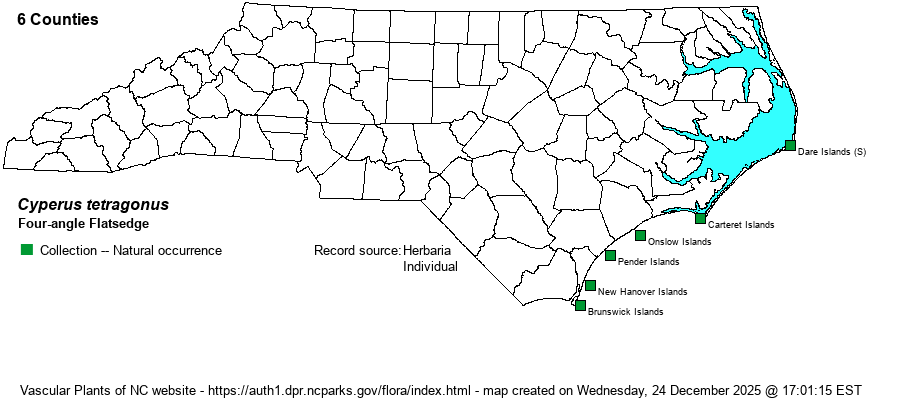| Author | Elliott | |
| Distribution | Restricted to the Outer Banks and other barrier islands; not known north of Buxton (Dare County) nor from the mainland.
Coastal Plain, NC to southern FL and southern AL. | |
| Abundance | Rare to locally uncommon. The NCNHP database lists 19 records, with about 11 of them still extant. It is a Special Concern species. | |
| Habitat | Maritime evergreen forests, especially in small openings and along trails; edges of brackish marshes. |
| Phenology | Flowering and fruiting July-September. | |
| Identification | The species generally grows 2-3 feet tall, with a "starburst" pattern of 5-9 spikes on long stalks. Each spike is elongate (roughly cylindrical in outline) and composed of well-spaced spikelets that are straw color or greenish tan. The loosely arranged spikelets, and the habitat, are distinctive. | |
| Taxonomic Comments | Excludes C. pringlei, which occurs in AZ and NM south through the Americas.
The genus Cyperus is mostly tropical and warm-temperate in distribution; thus, in NC it is much commoner in the Coastal Plain than in the Mountains and Piedmont. Most species have 1-few flowering stems (culms) from grasslike basal leaves, plus a few stem leaves. At the summit is an inflorescence of very open and branched, or tightly packed, spikes, varying among species from brown to golden brown to straw-color to reddish. The arrangement of the spikelets is important, whether like a hand (digitate) or in paired or alternate rows (pinnate); as is the shape of the achene (seed), whether bi-convex in cross-section or triangular. As a group, Cyperus tends to be weedy and readily enters disturbed ground; this is true for many natives as well as all the aliens. In recent years, following DNA research, the genus has incorporated several genera that in RAB (1968) or other manuals were separate: Hemicarpha, Lipocarpha, and Kyllinga. | |
| Other Common Name(s) | None | |
| State Rank | S2 | |
| Global Rank | G4 | |
| State Status | SC-V | |
| US Status | | |
| USACE-agcp | FAC link |
| USACE-emp | FAC link |

